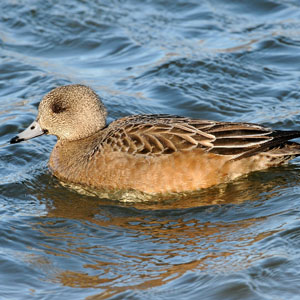Pratique | Identification
Distinguer les femelles des Canards d’Amérique (à front blanc) et siffleur

La femelle du Canard d’Amérique ou à front blanc (Mareca americana) est très difficile à distinguer de celle du Canard siffleur (M. penelope).
Photographie : Peter Massas / Wikimedia Commons
Introduction
Le Canard siffleur (Mareca penelope) est bien connu en Europe de l’Ouest, notamment quand des centaines d’oiseaux pâturent en hiver sur les prairies du littoral Atlantique. Mais il existe en Amérique du Nord une espèce proche, le Canard d’Amérique ou à front blanc (M. americana); si les deux mâles sont faciles à distinguer en plumage nuptial, ce n’est vraiment pas le cas des femelles (mais aussi des immatures et des mâles en plumage d’éclipse); or il est parfois possible, surtout en automne, d’observer une femelle (ou un immature) de Canard d’Amérique dans un groupe de Canards siffleurs.
Cet article rappelle les critères utiles sur le terrain pour vous aider à repérer plus facilement un éventuel oiseau « suspect ». Il est basé notamment sur une note intitulée « Photographic summary and notes on identification of female Eurasian Wigeon » rédigée par Kurt Radamaker, Pierre Deviche et Chris Benesh et publiée sur le site web de l’Arizona Field Ornithologists.
Abstract
American Wigeon Mareca americana and Eurasian Wigeon Mareca penelope are two closely related species. If adults in alternate plumage are unmistakable, they are very similar in female, immature and eclipse male plumages and are only safely distinguished in flight by its gray, not white, axillars, and sometimes by the lack of contrast between head and back plumage. An American Wigeon can sometimes be found among Eurasian wigeons in Western Europe, and hybrid American x Eurasian Wigeons are regularly found in winter in some areas, for example in the Washington state (United States).
This article deals with field key features to distinguish females (with notes about immature and eclipse male plumages) from both species. It is partly based on the following article: « Photographic summary and notes on identification of female Eurasian Wigeon » by Kurt Radamaker, Pierre Deviche and Chris Benesh.
Poursuivez la lecture de cet article, en vous abonnant dès maintenant !
Découvrez les Archives d’Ornithomedia.com
Pour seulement 10,00 €TTC/an (ou 6,00 € les 6 mois)
Profitez de plusieurs centaines d’articles en accès illimité et sans aucun engagement.
Compléments
Ouvrage recommandé
Le Guide Ornitho de L. Svensson et al
Sources
- Kurt Radamaker, Pierre Deviche, and Chris Benesh, Arzone Field Ornithologists: www.azfo.org/gallery/EUWI_female.html
- C. Cox , J. Barry, Aging of American and Eurasian Wigeons in Female-type plumages. www.americanbirding.org
- Northern Prairie Wildlife Research Center. Upper wings of American Wigeon: http://www.npwrc.usgs.gov/resource/birds/duckplum/amwigeon.htm
- Bellrose, F.C. 1976. Ducks,Geese, and Swans of North America. Stackpole Books, Harrisburg.
- Hamilton, R. 1996.Answers to the June photo quiz. Birding 28:309-313.
- Harrop,A. 1994. Field identification of American Wigeon. Birding World 7:50-56.
- Howell, S.N.G. 2003. All you ever wanted to know about molt but were afraid
to ask. Part II: Finding order amid the chaos. Birding 36:640-651. - Howell, S.N.G., C. Corben, P. Pyle, and D.I. Rogers. 2003. The first basic problem:
- A review of molt and plumage homologies. Condor 105:635-653.
- Humphrey, P.S., and K.C. Parkes. 1959 An approach to the study of molts and plumages. Auk 76:1-31.
- Jiquet, F. 1999. Photo forum: Hybrid American Wigeons. Birding World
12:247-252. - Larkin, P. 2000. Eyelid colour of American Wigeon. British Birds 93:39-40.
- Lewington, I., P. Alström, and P. Colston. 1992. Rare Birds of Britain and Europe. Harper Collins, London.
- Madge, S., and H. Burn. 1988.Waterfowl: An Identification Guide to Ducks,Geese, and Swans of the World. Houghton Mifflin, Boston.
- Mowbray, T. 1999. American Wigeon, in: A. Poole and F. Gill, eds. The Birds of North America, no. 401. Birds of North America, Philadelphia.
- Svensson, L., K. Mullarney, D. Zetterstrom, and P.J. Grant. 1999. Birds of Europe. Harper Collins, London.
- Votier, S.C., A.H.J. Harrop, and M.Denny. 2003. A review of status and identification of American Wigeon in Britain and Ireland. British Birds 96:2-22.





Aucun commentaire sur ce sujet
Participer à la discussion !